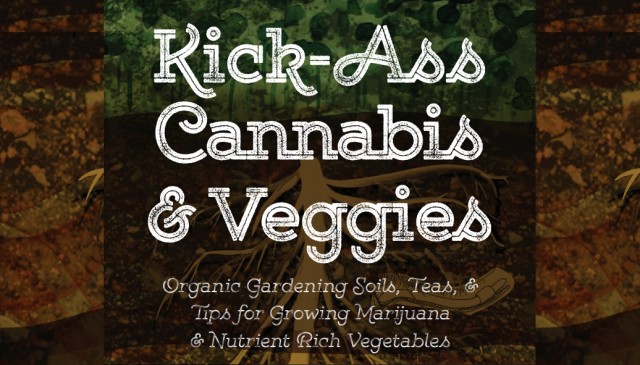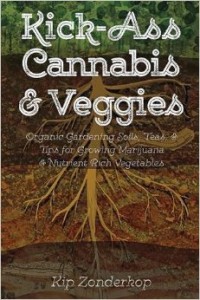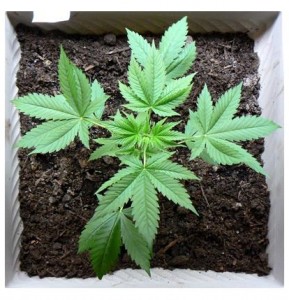 I recently sat down to read a book titled, Kick-Ass Cannabis and Veggies: Organic Gardening Soils, Teas & Tips for Growing Marijuana & Nutrient Rich Vegetables, by Kip Zonderkop.
I recently sat down to read a book titled, Kick-Ass Cannabis and Veggies: Organic Gardening Soils, Teas & Tips for Growing Marijuana & Nutrient Rich Vegetables, by Kip Zonderkop.
Zonderkop describes this short book in a concise sentence, “This book explains organic gardening techniques that are based on soil science and permaculture principles,” and after reading it, I can only agree. The breakdown of the book is simple and easy to follow. However, one may need to pull up the references used, or have a few other books on hand (such as another book I am reading now, The Cannabis Encyclopedia by Jorge Cervantes) for more in depth information on the topic of interest.
 There are 6 chapters in all, titled as follows: Soil, Garden Pots, Waters, Teas & Foliar Sprays, Compost Worms, and Cannabis Considerations and Organic Gardening in Eight Steps. This far into the book I only have one pet peeve — the title. Why use the word “cannabis” once, then switch to “marijuana?” Of note is that he doesn’t use the term marijuana ever again in the book itself, but that doesn’t change how I feel about cannabis terminology.
There are 6 chapters in all, titled as follows: Soil, Garden Pots, Waters, Teas & Foliar Sprays, Compost Worms, and Cannabis Considerations and Organic Gardening in Eight Steps. This far into the book I only have one pet peeve — the title. Why use the word “cannabis” once, then switch to “marijuana?” Of note is that he doesn’t use the term marijuana ever again in the book itself, but that doesn’t change how I feel about cannabis terminology.
As I read through the first couple chapters on Soil, Garden Pots, Waters and Teas & Foliar Sprays, I found myself knowing most of the information provided (though I do have a Bachelor’s degree in Plant Biology). I wish he would have noted what plants are known to need, such as which nutrients (namely N, P, K) and how each benefit the plant, since it seems to be the information I get asked most from novice gardeners.
I also noted that the author loved composting and had the important facts down for the most part, especially noting that letting the newly mixed or composted soil sit for a few weeks is of utmost importance and a step many eager gardeners and growers omit.
Getting further into the pages, I couldn’t let it go how much he is into peat moss. As a sustainable, organic and vegan gardener myself, I cannot allow the use of peat moss (decomposed sphagnum moss) in my garden for several reasons:
- It is not necessary. It is known to only keep moisture until the time it dries out once, then it can never be re-wet.
- As an amendment, it is also a poor choice. It decomposes rather quickly, which can allow the surrounding soil to compress onto the roots and thus decrease the air flow to the roots.
- Most importantly, its use is absolutely horrible for the environment. This is because it is a mined product and it takes hundreds, if not thousands of years to recoup the loss to the habitat (bogs and wetlands) from which it came. Additionally, peat moss bogs have about 10% of all fixed carbon contained under their surfaces, which also traps CO2 and helps with the climate war we are currently facing. If we continue to harvest these peat moss bogs, we will only be feeding the climate change curve to the worst.
So choose your amendments wisely. I, and many other organic and sustainable gardeners, stick with leaf litter or decomposing leaves called “green manure,” in place of peat. The author does touch on “green manure,” on page 20 (chapter 2: Garden Pots).
 On the other hand, I was extremely happy to see how much he loved worms. Worms are one of the greatest creatures on the Earth, maybe not between your toes as you dance in the rain, but most definitely in the soil of your beloved plants — cannabis and vegetable alike. If you can pay attention to Chapter 4, I can say your soil will be the most happy it’s ever been, simply because the worms do most of the work, all you have to do is feed them.
On the other hand, I was extremely happy to see how much he loved worms. Worms are one of the greatest creatures on the Earth, maybe not between your toes as you dance in the rain, but most definitely in the soil of your beloved plants — cannabis and vegetable alike. If you can pay attention to Chapter 4, I can say your soil will be the most happy it’s ever been, simply because the worms do most of the work, all you have to do is feed them.
The most relevant chapter for us weedists is Chapter 5: Cannabis Considerations. Here, Zonderkop talked about the most important details, including growing conditions, energy savings and genetics.
I am impressed with the amount of information provided on air quality, air flow, CO2 vs oxygen, air humidity and how to measure and control each factor. These are very important with indoor cannabis growing, and really, with all indoor gardens.
He also made sure the reader is aware of new light bulb technology and how LED’s can reduce the overall expense and environmental impact of growing indoors. He finished off the chapter well, exploring proper planting techniques, water techniques, growing and lighting conditions, as well as how to “sex” or determine the sex of plants, and finally how to cut, trim, dry and cure the cannabis harvest with basic, yet proper, approach.
Chapter 6 is the most in-depth chapter of this book, giving step-by-step instruction on how to make the best soil you possibly can. I can say this is where I started out way back in the early days of making my own soils, compost and compost teas with trial and error. Many years later, I’ve now learned a lot more and can supplement the information provided in this book.
I can say wholeheartedly, if you follow this book, without a doubt you’ll have a “Kick-Ass” garden for sure.
Check out other Weedist Book Reviews!









